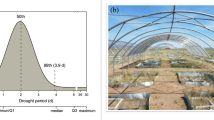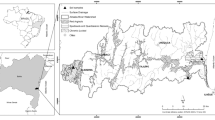Abstract
Tamarix spp. (Saltcedar) is a facultative phreatophyte that can tolerate drought when groundwater is not accessed. In addition to deep water uptake, hydraulic redistribution (HR) is another factor contributing to the drought tolerance of Tamarix spp. In this study, data on soil volumetric moisture content (θ), lateral root sap flow, and relevant climate variables were used to investigate the patterns, magnitude, and controlling factors of HR of soil water by roots of Tamarix ramosissima Ledeb. in an extremely arid land in Northwest China. Results showed evident diurnal fluctuations in θ at the depths of 30 and 50 cm, indicating “hydraulic lift” (HL). θ increased remarkably at 10 and 140 cm but decreased at 30 and 50 cm and slightly changed at 80 cm after rainfall, suggesting a possible “hydraulic descent” (HD). However, no direct evidence was observed in the negative flow of lateral roots, supporting HR (including HL and HD) of T. ramosissima. The HR pathway unlikely occurred via lateral roots; instead, HR possibly occurred through adventitious roots with a diameter of 2–5 mm and a length of 60–100 cm. HR at depths of 20–60 cm ranged from 0.01–1.77 mm/d with an average of 0.43 mm/d, which accounted for an average of 22% of the estimated seasonal total water depletion at 0–160 cm during the growing season. The climate factors, particularly vapor pressure deficit and soil water potential gradient, accounted for at least 33% and 45% of HR variations with depths and years, respectively. In summary, T. ramosissima can be added to the wide list of existing species involved in HR. High levels of HR may represent a considerable fraction of daily soil water depletion and substantially improve plant water status. HR could vary tremendously in terms of years and depths, and this variation could be attributed to climate factors and soil water potential gradient.
Similar content being viewed by others
References
Allen R G, Pereira L S, Raes D, et al. 1998. Crop evapotranspiration-guidelines for computing crop water requirements-FAO Irrigation and Drainage Paper 56, FAO, Rome, Italy.
Anderson J E. 1982. Factors controlling transpiration and photosynthesis in Tamarax Chinensis Lour. Ecology, 63: 48–56.
Brooks J R, Meinzer F C, Warren J M, et al. 2006. Hydraulic redistribution in a Douglas-fir forest: lessons from system manipulations. Plant, Cell & Environment, 29: 138–150.
Burgess S S O, Adams M A, Turner N C, et al. 1998. The redistribution of soil water by tree root systems. Oecologia, 115: 306–311.
Burgess S S O, Pate J S, Adams M A, et al. 2000. Seasonal water acquisition and redistribution in the Australian woody phreatophyte, Banksia prionotes. Annals of Botany, 85: 215–224.
Burgess S S O, Adams M A, Turner N C, et al. 2001. An improved heat pulse method to measure low and reverse rates of sap flow in woody plants. Tree Physiology, 21: 589–598.
Busch D E, Ingraham N L, Smith S D. 1992. Water uptake in woody riparian phreatophytes of the southwestern United States: a stable isotope study. Ecological Applications, 2: 450–459.
Caldwell M M, Richards J H. 1989. Hydraulic lift: water efflux from upper roots improves effectiveness of water uptake by deep roots. Oecologia, 79: 1–5.
Cleverly J R, Smith S D, Sala A, et al. 1997. Invasive capacity of Tamarix ramosissima in a Mojave Desert floodplain-the role of drought. Oecologia, 111: 12–18.
Dawson T E. 1993. Hydraulic lift and water use by plants-implications for water balance, performance and plant-plant interactions. Oecologia, 95: 565–574.
Devitt D A, Smith S D, Neuman D S. 1997. Leaf carbon isotope ratios in three landscape species growing in an arid environment. Journal of Arid Environments, 36: 249–257.
Domec J C, King J S, Noormets A, et al. 2010. Hydraulic redistribution of soil water by roots affects whole-stand evapotranspiration and net ecosystem carbon exchange. New Phytologist, 187: 171–183.
Feng Q, Cheng G D. 1998. Current situation, problems and rational utilization of water resources in arid north-western China. Journal of Arid Environments, 40: 373–382.
Gries D, Zeng F J, Foetzki A, et al. 2003. Growth and water relations of Tamarix ramosissima and Populus euphratica on Taklamakan desert dunes in relation to depth to a permanent water table. Plant, Cell & Environment, 26: 725–736.
Hultine K R, Williams D G, Burgess S S O, et al. 2003. Contrasting patterns of hydraulic redistribution in three desert phreatophytes. Oecologia, 135: 167–175.
Hultine K R, Scott R L, Cable W L, et al. 2004. Hydraulic redistribution by a dominant, warm-desert phreatophyte: seasonal patterns and response to rainfall pulses. Functional Ecology, 18: 530–538.
Jackson R B, Canadell J, Ehleringer J R, et al. 1996. A global analysis of root distributions for terrestrial biomes. Oecologia, 108: 389–411.
Jackson R B, Mooney H A, Schulze E D. 1997. A global budget for fine root biomass, surface area, and nutrient contents. Proceedings of the National Academy of Sciences, 94: 7362–7366.
Kurz-Besson C, Otieno D, Lobo do Vale R, et al. 2006. Hydraulic lift in cork oak trees in a Savannah-type Mediterranean ecosystem and its contribution to the local water balance. Plant and Soil, 282: 361–378.
Lambers H, Chapin III F S, Pons T L. 2008. Plant water relations. In: Lambers H, Chapin III F S, Pons T L. Plant Physiological Ecology. New York: Springer Science+Business Media, 163–217.
Liu C, Chen Y N, Xu Z. 2010. Eco-hydrology and sustainable development in the arid regions of China. Hydrological Processes, 24: 127–128.
Ludwig F, Dawson T E, Kroon H, et al. 2003. Hydraulic lift in Acacia tortilis trees on an East African savanna. Oecologia, 134: 293–300.
Nagler P, Scott R, Westenburg C, et al. 2005. Evapotranspiration on western U.S. rivers estimated using the Enhanced Vegetation Index from MODIS and data from eddy covariance and Bowen ratio flux towers. Remote Sensing of Environment, 97: 337–351.
Nagler P L, Glenn E P, Lewis T T. 2003. Comparison of transpiration rates among saltcedar, cottonwood and willow trees by sap flow and canopy temperature methods. Agricultural and Forest Meteorology, 116: 73–89.
Neumann R B, Cardon Z G. 2012. The magnitude of hydraulic redistribution by plant roots: a review and synthesis of empirical and modeling studies. New Phytologist, 194: 337–352.
Nippert J B, Butler J J, Kluitenberg G J, et al. 2010. Patterns of Tamarix water use during a record drought. Oecologia, 162: 283–292.
Oliveira R S, Dawson T E, Burgess S S O. 2005. Evidence for direct water absorption by the shoot of the desiccation-tolerant plant Vellozia flavicans in the savannas of central Brazil. Journal of Tropical Ecology, 21: 585–588.
Pataki D E, Bush S E, Gardner P, et al. 2005. Ecohydrology in a Colorado River riparian forest: implications for the decline of Populus fremontii. Ecological Applications, 15: 1009–1018.
Prieto I, Armas C, Pugnaire F I. 2012. Hydraulic lift promotes selective root foraging in nutrient-rich soil patches. Functional Plant Biology, 39: 804–812.
Richards J H, Caldwell M M. 1987. Hydraulic lift: substantial nocturnal water transport between soil layers by Artemisia tridentata roots. Oecologia, 73: 486–489.
Ryel R J, Caldwell M M, Yoder C K, et al. 2002. Hydraulic redistribution in a stand of Artemisia tridentata: evaluation of benefits to transpiration assessed with a simulation model. Oecologia, 130: 174–183.
Sala A, Smith S D, Devitt D A. 1996. Water use by Tamarix ramosissima and associated phreatophytes in a Mojave desert floodplain. Ecological Applications, 6: 888–898.
Si J H, Feng Q, Zhang Y W, et al. 2005. Growing season evapotranspiration from Tamarix ramosissima stands under extreme arid conditions in northwest China. Environmental Geology, 48: 861–870.
Siqueira M, Katul G G, Porporato A. 2008. Onset of water stress, hysteresis in plant conductance, and hydraulic lift: scaling soil water dynamics from millimeters to meters. Water Resources Research, 44: W01432.
Warren J M, Meinzer F C, Brooks J R, et al. 2007. Hydraulic redistribution of soil water in two old-growth coniferous forests: quantifying patterns and controls. New Phytologist, 173: 753–765.
Warren J M, Brooks J R, Dragila M I, et al. 2011. In situ separation of root hydraulic redistribution of soil water from liquid and vapor transport. Oecologia, 166: 899–911.
Xi H Y, Feng Q, Si J H, et al. 2011. Spatio-temporal characteristics of soil in Ejina oasis. Journal of Desert Research, 31: 68–75.
Xu H, Li Y. 2006. Water-use strategy of three central Asian desert shrubs and their responses to rain pulse events. Plant and Soil, 285: 5–17.
Zhao L J, Xiao H L, Cheng G D, et al. 2008. A preliminary study of water sources of riparian plants in the lower reaches of the Heihe basin. Acta Geoscientica Sinica, 29: 709–718.
Zhou X, Fang B, Cao W B, et al. 2004. Occurrence of water and salts in the unsaturated zone in the Ejin oasis in Northwest China. Geological Review, 50: 384–390.
Author information
Authors and Affiliations
Corresponding author
Rights and permissions
About this article
Cite this article
Yu, T., Feng, Q., Si, J. et al. Patterns, magnitude, and controlling factors of hydraulic redistribution of soil water by Tamarix ramosissima roots. J. Arid Land 5, 396–407 (2013). https://doi.org/10.1007/s40333-013-0173-z
Received:
Revised:
Accepted:
Published:
Issue Date:
DOI: https://doi.org/10.1007/s40333-013-0173-z




